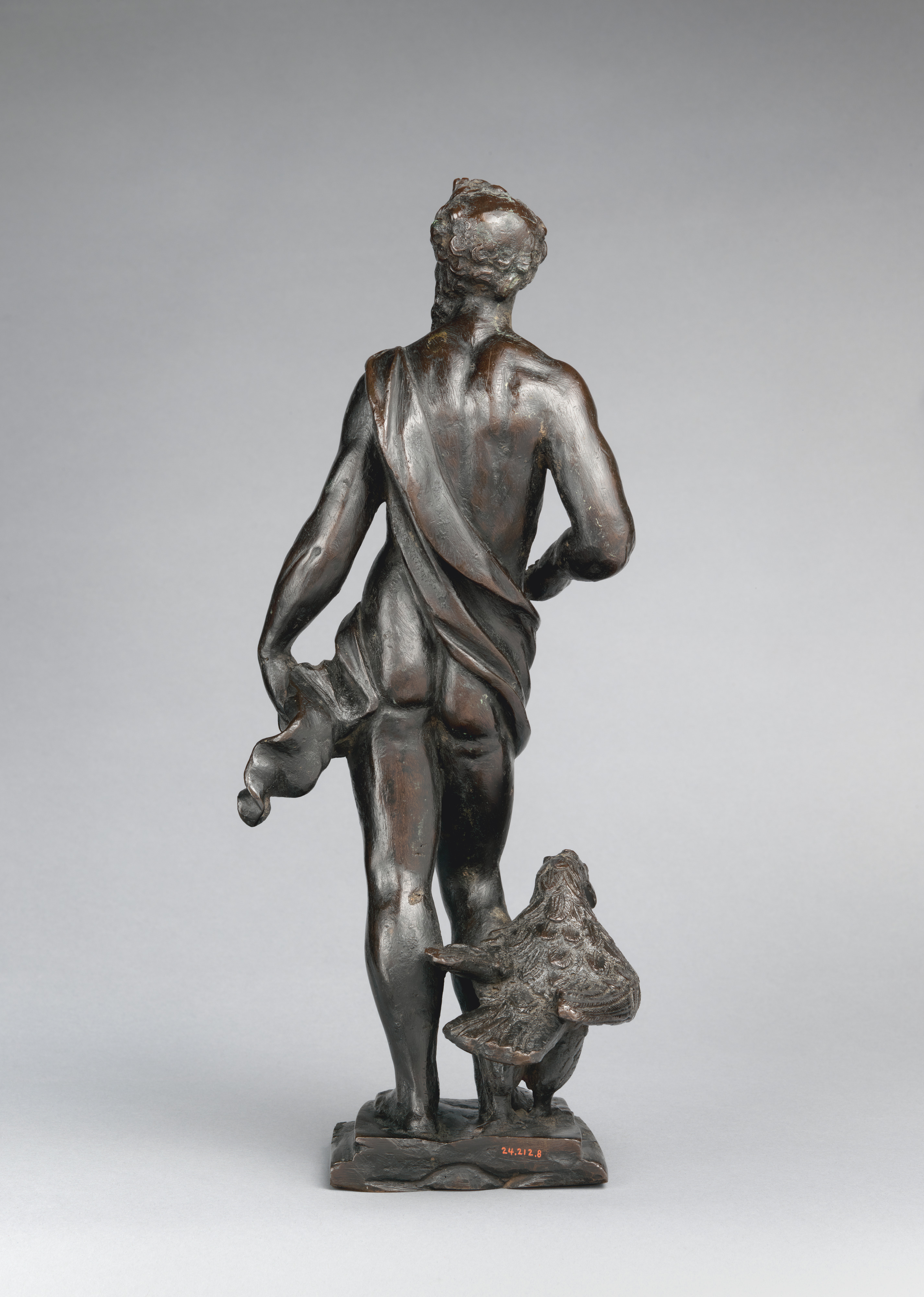Jupiter with a thunderbolt
Possibly from the workshop of Joseph de Levis Italian
Standing upright in classic contrapposto stance, with the weight resting on the proper left leg, this figure of a mature man with luxurious hair and beard is nude but for a small piece of loincloth held in place by a shoulder strap. He grasps a fluttering piece of the cloth in his left hand and a thunderbolt in his right. This attribute and a small eagle sitting next to his right leg identify him as Jupiter. The statuette is placed on a trapezoidal base with a steplike, lower edge running around the front and two sides into which a stylized egg-and-dart ornament is incised. The back side of this unusual base was cut off in the wax as if the statuette were to be fitted into a setting like a niche; however, the protruding eagle’s tail would prevent such an installation. Since the crowning figures of andirons generally have round or triangular bases, it seems that this statuette was intended for another, unknown purpose.
The model exists in several versions, in the Hermitage,[1] the National Gallery in Washington, D.C.,[2] the Museo Correr in Venice,[3] and the Museo Amedeo Lia in La Spezia.[4] It was probably conceived as a figure for an andiron and appears as such, together with a nude Juno—having a peacock sitting next to her as pendant to Jupiter’s eagle—on firedogs once in the Donà delle Rose collection.[5] Giovanni Mariacher attributed the casts in Venice and Washington to Jacopo Sansovino, but this attribution can be rejected for obvious stylistic incompatibility.[6] Sergei Androsov linked the model to Girolamo Campagna, referring to a similar statuette—sans thunderbolt and featuring a dog instead of an eagle—offered at Christie’s in 1967 that is incised with the letters “IC” in the base.[7] Appearing on a small group of bronze statuettes, the enigmatic “IC” signature has been analyzed repeatedly and variously assigned to Jean Chenet, Girolamo Campagna, his brother Giuseppe, and Giacomo Calderari, but today the initials are considered to be those of an unknown Venetian caster.[8] Charles Avery’s suggestion that the Jupiter in La Spezia may come from the workshop of Joseph de Levis offers a more promising lead.[9]
The Met’s Jupiter with a Thunderbolt, while not an exceptional bronze, is a genuine late Renaissance piece. In spite of the careless modeling and rough chasing, it still constitutes the best example of the model. The composition is stylistically close to Alessandro Vittoria but certainly not by his hand,[10] whereas it is difficult to see any convincing similarities to Girolamo Campagna. The workshop of de Levis, who was a clever caster but not a great sculptor in his own right, and who was often inspired by Vittoria, appears thus indeed, as suggested by Avery for the version in La Spezia, to be the most likely candidate for its manufacture.
-CKG
Footnotes
(For key to shortened references see bibliography in Allen, Italian Renaissance and Baroque Bronzes in The Metropolitan Museum of Art. NY: The Metropolitan Museum of Art, 2022.)
1. Androsov 1978, pp. 57–58, cat. 42; cast with a thick, triangular base.
2. C. Wilson 1983, p. 137. This cast (mounted on a firedog, its companion surmounted by a figure of Juno) was most probably made in the nineteenth century for it has a suspiciously smooth surface, while the drapery features mechanical stippling. The eagle is of a different type and sits next to the figure’s left rather than right leg. For a Jupiter just like it (e.g., smooth surface, same type of eagle) on a pair of firedogs in the Vok collection, see Banzato 2004, pp. 72–75, cat. 23.
3. Mariacher 1971, p. 36. The eagle is missing in this cast, which is paired with a Juno of the same type as on the firedogs formerly in the Donà delle Rose collection; see Planiscig 1930, pl. CLX.
4. Charles Avery in Ratti and Acordon 1998, p. 174, no. 106.
5. See note 3.
6. Mariacher 1966, p. 23; Mariacher 1968, cat. 22; Mariacher 1971, p. 36.
7. Androsov 1978, p. 58; Christie’s, London, November 20, 1967, lot 167. Although the friendly animal represented here hardly looks like Cerberus, that is what it presumably must be, so the elderly man could be interpreted as Pluto. The cute dog is the same type that accompanies an Adonis paired with a Venus, a couple found on numerous firedogs.
8. For a fuller discussion, see cat. 75.
9. Avery in Ratti and Acordon 1998, p. 174.
10. Planiscig 1930, pl. CLX, attributed the firedogs then in the Donà delle Rose collection to Vittoria.
This image cannot be enlarged, viewed at full screen, or downloaded.
This artwork is meant to be viewed from right to left. Scroll left to view more.





